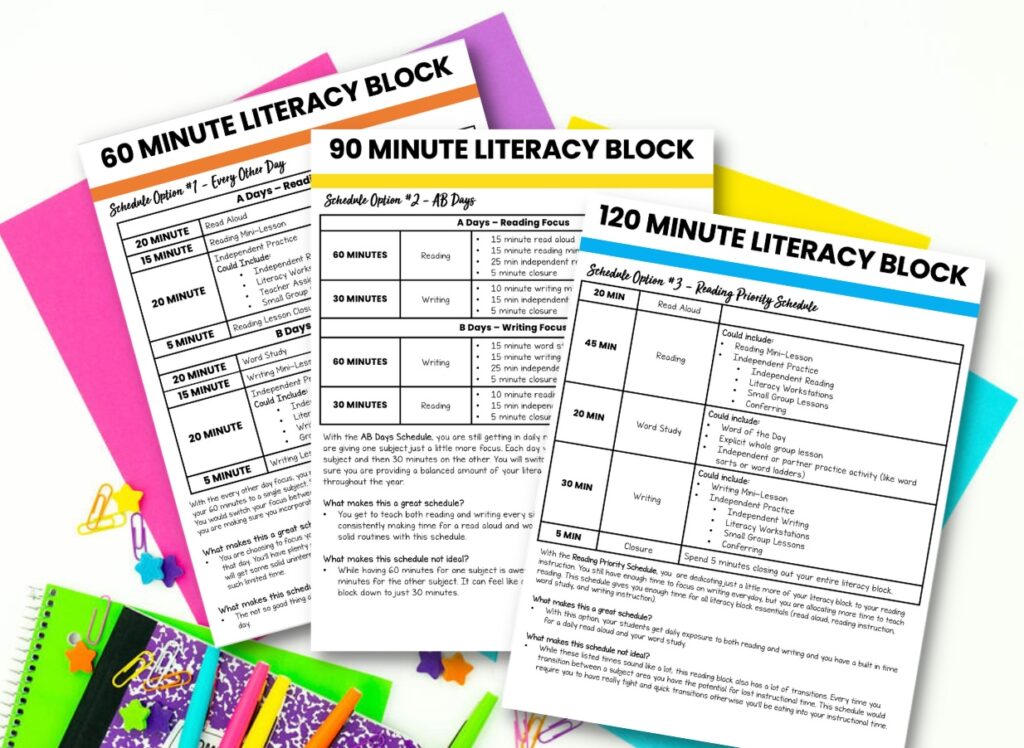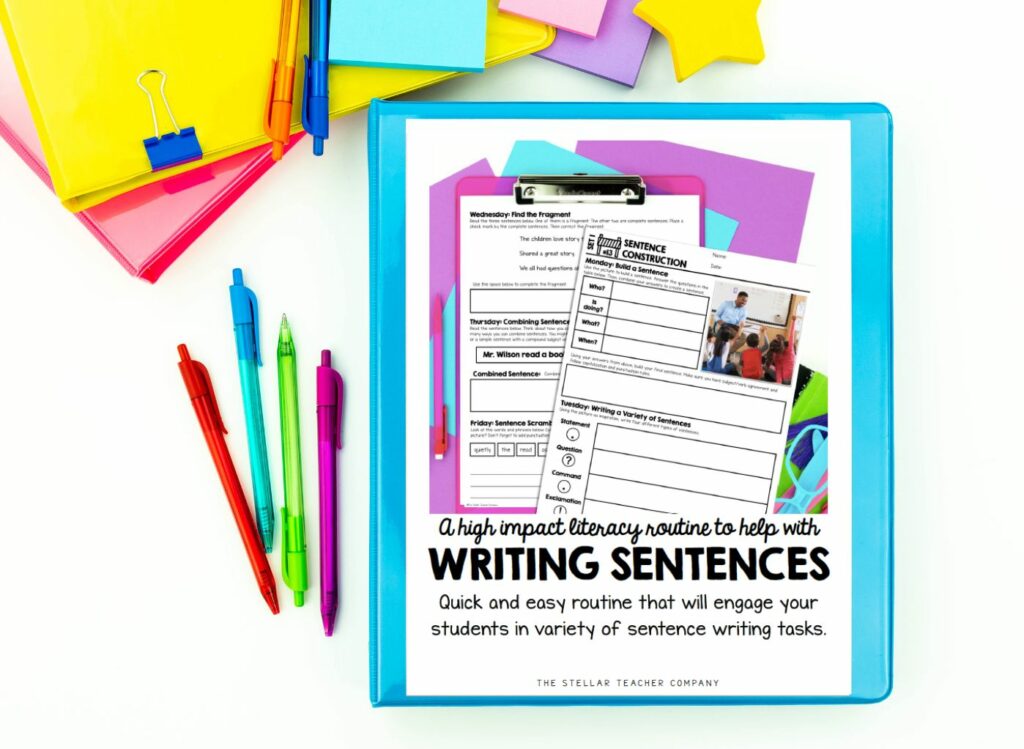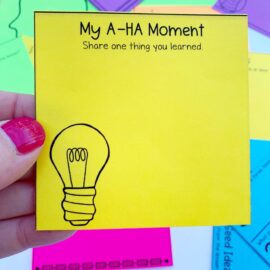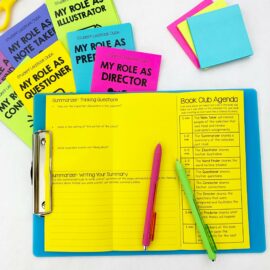When you sit down to plan and try create a classroom schedule that includes word study, grammar, reading, and writing in your ELA block, what feelings come up for you? Stress, overwhelm, pressure. . . it might even feel impossible! If you are tired of feeling like you just don’t have the time to squeeze it all in, I’ve got four tips to share that I hope will make you feel more confident that you CAN fit all these elements into your classroom schedule.
So, what is the best way to fit word study, grammar, vocabulary, reading, and writing into one ELA block? This is a question I get a lot – it’s been asked in our Stellar Teacher Membership, our upper elementary teacher Facebook group, in Instagram DMs, and in emails.
Teachers have so much to do and very little time to do it!
Now, let’s get to these tips for your classroom schedule.

Tip #1: Avoid Thinking About Your Literacy Instruction As Isolated Elements
Sometimes, the overwhelm of fitting everything in comes with the idea that we need to set aside time for each element we want to teach. I know for many years, my classroom schedule looked a little like this:
- 10 min for word work every day
- 15 min for vocabulary
- 30 min for reading
- 10 min for grammar
- 20 min for writing
This type of schedule feels chopped up and doesn’t lend itself to teaching, practicing, and mastering any skills. Although this type of schedule may be ideal for some of us, a more realistic approach to instruction is necessary to fit everything in!
Instead of thinking about literacy as isolated skills to be taught in chunks, I encourage you to take a more holistic approach to your literacy instruction.
- Rather than focusing on every element in your literacy block every day, prioritize the new objectives you are teaching or the objectives your students need more time to practice.
- Check out Episode #27 of the podcast to learn more about creating a literacy schedule that is beneficial to you and your students – even with a limited amount of time!
Tip #2: Create a Classroom Schedule that Includes High-Impact Routines
Okay, the holistic approach sounds great, but what if you are at a school that requires you to teach every element of literacy every single day?
Creating high-impact literacy routines during your literacy blocks can help you do that efficiently and effectively! A routine is a system, process, or structure used in your classroom that can be successfully repeated and automated.
Why do we want to use high-impact routines in our classroom schedule? Routines save us time! When we feel strapped for time, a routine can help us use the time we do have in more meaningful ways.
A few routines I used in my classroom were:
- Word of the Week
- Picture of the Day
- Sentence Writing Routine
But there are so many more you can fit into your literacy block to make good use of time:
- Story of the Week
- Genre of the Week
- Writing Prompt of the Week
- Grammar Rule of the Week
. . . and more! You can create a routine for anything.
Using routines during your literacy block eliminates the need to constantly explain directions to your students, which means you are saving time! And in turn, you are providing consistent practice in various areas that will benefit your students.

Tip #3: Find Ways to Overlap Instruction in Your Classroom Schedule
I hope you’ll find this tip the easiest and most beneficial. You intentionally connect everything in your literacy block when you overlap instruction.
If your current classroom schedule is broken into silos, I encourage you to think about how you can overlap instruction. We lose instructional time when we transition from one subject to the next. For example, if you are teaching reading, then moving to writing, then switching to grammar. . . think about all the minutes you’re losing during those transitions!
It all adds up.
Avoid the loss of meaningful minutes by embedding multiple literacy skills into the same lesson. Here are some ideas to try:
- Use the same mentor text for reading and writing.
- Teach students the writing process while they are working on writing about reading.
- Identify vocabulary words with greek or Latin roots or even figurative language in the mentor text.
- Point out spelling patterns whenever you can.
- Look for mentor sentences or examples of grammar rules in your reading text.
And don’t forget to bring ALL parts of literacy into your small group lessons!
Whatever your small group structure is, guided reading, strategy lessons, or even book clubs, you can and should pull in all parts of literacy to your small group lessons. For example, if you use book clubs, have students work through the writing process at the end of their book to summarize the text or break down and analyze a mentor sentence.
Tip #4: Utilize Other Parts of Your Classroom Schedule
If you are departmentalized, I understand this may be difficult, but if you are self-contained, this could give you many opportunities for more literacy practice!
Think about borrowing from other parts of your day to sneak in some reading/writing instruction.
For example, add vocabulary practice to other subjects like math or science. In other subjects, you can still practice literacy skills like:
- Dictionary skills
- Prefixes and Suffixes
- Using context clues
Comprehension is an easy and meaningful addition to your science and social studies time. Give students a reading comprehension graphic organizer to use with their Science/Social studies text to practice:
- Main Idea
- Asking Questions
- Summarizing
- Text Features
- Text Structure
Writing can be done at ANY point of the day with ANY subject! Whether it be during math, science, social studies, reading, or even a daily reflection as part of your SEL curriculum, use it to teach and practice writing objectives you are currently focusing on.
Teaching other content areas doesn’t have to be separated or isolated from what you teach during your literacy block. Integrating literacy objectives into your other subject areas allows students to practice reading and writing authentically.
If these tips have you ready to rework your literacy block schedule, I have a free set of sample schedules you need to check out! This freebie includes schedule ideas for literacy blocks that range from 70 minutes up to 120 minutes! Check them out.
Put it into practice…
- Here is your challenge. Pick at least one of these tips to try out right away! Even if it feels a bit uncomfortable or difficult, try it anyway. And don’t forget to download the freebie to help you build out a more intentional schedule for you and your students.
- Check out Episode #59 of the podcast to learn more about Simplifying the Struggle of Fitting Everything Into Your Literacy Block!
- Come join us inside The Stellar Literacy Collective. You’ll get access to a resource library filled with reading and writing activities for you to support your students all year long, including many pre-made high-impact literacy routines you can start implementing right away!












Leave a Comment
You must be logged in to post a comment.